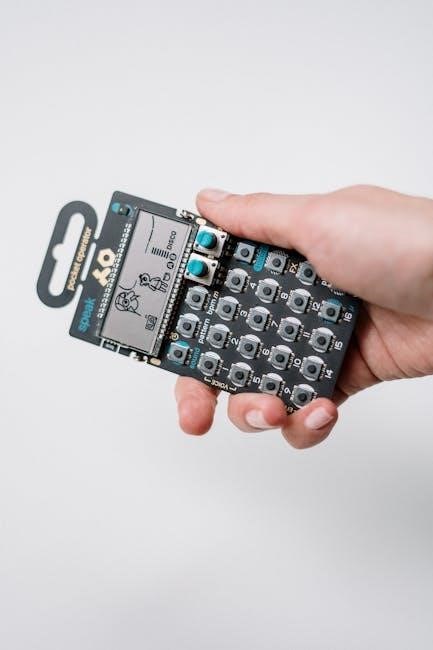Manual Solar Charge Controller: A Comprehensive Guide
Solar charge controllers, often referred to as solar battery maintainers or solar charge regulators, play a pivotal role in battery-based solar power systems․ They regulate voltage from solar panels, preventing overcharging and ensuring efficient energy transfer․ This guide will explore the essential aspects of these devices․
Solar charge controllers are indispensable components in off-grid solar power systems, acting as the gateway between solar panels and batteries․ Their primary function is to regulate the voltage and current flowing from the solar panels to the battery bank, ensuring optimal charging conditions and preventing damage due to overcharging or over-discharging․ These devices manage the power output of solar cell components and batteries, catering to the load’s power demands․ Acting as the core control element within a photovoltaic power supply system, a charge controller optimizes the battery’s charging and discharging cycles, contributing to its longevity and overall system efficiency․
Essentially, a solar charge controller is a voltage or current regulator․ When batteries are low, the controller facilitates full current flow from solar panels, replenishing the battery banks․ Upon reaching a full charge, it limits the current, maintaining optimal levels․ Understanding the controller’s type and operation is crucial for troubleshooting and verifying its proper functioning within the solar setup․
Why Solar Charge Controllers are Essential
Solar charge controllers are essential components in any battery-based solar power system that isn’t connected to a city grid, playing a significant role in the efficiency and longevity of solar power systems․ Primarily, they protect the battery bank from overcharging, a condition that can severely damage the entire system․ By regulating the charge cycles, these controllers ensure the battery operates within safe voltage limits, preventing premature degradation and extending its lifespan․ Without a charge controller, the unregulated power from solar panels can lead to battery overheating, gassing, and ultimately, failure․
Furthermore, charge controllers prevent over-discharging, safeguarding the battery from damage caused by excessive depletion․ They also block reverse current flow from the batteries to the solar panels during nighttime or periods of low sunlight․ Overall, these controllers are vital for maintaining battery health, optimizing system performance, and ensuring a reliable and durable solar power setup, especially for off-grid applications․
Types of Solar Charge Controllers

Solar charge controllers come in several types, each with varying functionalities and suitable applications․ The most common are Pulse Width Modulation (PWM) controllers and Maximum Power Point Tracking (MPPT) controllers․ PWM controllers regulate the voltage from the solar panels to the batteries by rapidly switching the connection on and off․ These are typically more cost-effective and suitable for smaller systems․
MPPT controllers, on the other hand, employ a more sophisticated approach․ They optimize the match between the solar array and the battery bank, maximizing energy transfer․ This makes them more efficient, especially in larger systems or when dealing with higher voltage panels․ Besides these, there are simpler 1- or 2-stage controllers, shunt regulators, and series regulators, each offering different levels of control and protection for the solar power system’s battery․
Pulse Width Modulation (PWM) Controllers
Pulse Width Modulation (PWM) controllers are a common type of solar charge controller utilized in solar power systems to regulate the flow of electricity from the solar panels to the batteries․ PWM controllers operate by delivering a series of short charging pulses to the battery, regulating voltage by switching the connection between the solar array and battery on and off rapidly․ This method maintains a constant voltage․
PWM controllers are a cost-effective option, especially for smaller solar systems where maximizing efficiency isn’t the primary concern․ However, due to the way they regulate voltage, PWM controllers can result in power loss․ PWM controllers operate at battery voltage, which is something to consider depending on the type of battery you are using․
Maximum Power Point Tracking (MPPT) Controllers
Maximum Power Point Tracking (MPPT) controllers represent a more advanced technology in solar charge controllers, designed to maximize charging efficiency, especially in larger off-grid installations with multiple solar panels․ Unlike PWM controllers, MPPT controllers operate at the maximum power voltage of the solar panel․ The general operation of MPPT is to pulse width modulate the power coming from the Solar panel into the battery, measuring the voltage and current of what’s flowing through․
MPPT controllers are highly recommended when you need maximum charging efficiency․ They adapt to changing conditions to optimize energy transfer․ MPPT controllers are more expensive but provide significantly greater efficiency․ When batteries are low, the controller provides a full flow of current from your solar panels to replenish your battery banks․
PWM vs․ MPPT: Key Differences and When to Use Each
Pulse Width Modulation (PWM) and Maximum Power Point Tracking (MPPT) controllers are the two most common types of solar charge controllers used in solar power systems․ PWM controllers are more affordable and best suited for smaller, portable solar systems․ PWM controllers operate at battery voltage, making them less efficient in maximizing power transfer from the solar panel to the battery․ In contrast, MPPT controllers use newer technology to operate at the maximum power voltage of the solar panel․
MPPT controllers are recommended for larger off-grid installations with multiple panels․ If maximum charging efficiency is a priority, MPPT is the preferred choice․ PWM controllers regulate the voltage and current from the solar panels to the batteries by rapidly switching the connection on and off․
Other Types of Solar Charge Controllers

While Pulse Width Modulation (PWM) and Maximum Power Point Tracking (MPPT) controllers are the most prevalent, other types of solar charge controllers exist, each with unique characteristics․ Simple 1- or 2-stage controllers represent a basic approach, controlling voltage in one or two steps․ These are often found in very small or simple solar setups where precise control isn’t critical․ Shunt regulators function by short-circuiting the solar array when the battery reaches full charge, diverting excess energy․
Series regulators, on the other hand, interrupt the connection between the solar panel and the battery when the battery is full, preventing overcharge․ These offer different levels of sophistication and are suitable for various applications․ Choosing the right controller depends on the specific system requirements and budget․
Simple 1- or 2-Stage Controllers
As the name suggests, simple 1- or 2-stage controllers provide a basic method of regulating voltage from solar panels to batteries; These controllers operate by either fully connecting the solar panel to the battery or disconnecting it entirely when the battery reaches a certain voltage threshold․ In a 2-stage controller, there might be an intermediate stage where the charging current is reduced before complete disconnection;
These controllers are typically used in small, low-power solar systems where cost is a primary concern and precise control is not essential․ They are less efficient than more sophisticated controllers like PWM or MPPT but offer a simple and inexpensive solution for basic solar charging needs․ They are the most basic type of controller․
Shunt Regulators
Shunt regulators represent an older technology in solar charge control, functioning by effectively short-circuiting the solar array when the battery voltage reaches its predetermined maximum․ This action diverts excess current away from the battery, preventing overcharging and potential damage․ However, this method is inherently wasteful as it dissipates the excess energy as heat, reducing the overall efficiency of the solar system․
While shunt regulators are relatively simple in design and can be cost-effective for small-scale applications, their inefficiency makes them less suitable for larger or more sophisticated solar power systems․ They are one of the four basic types of charge controllers․ Modern designs have largely moved away from shunt regulators in favor of more efficient technologies like PWM and MPPT․
Series Regulators
Series regulators offer a different approach to solar charge control․ Unlike shunt regulators, which short-circuit the solar panel, series regulators interrupt the current flow from the solar panel to the battery when the battery reaches its full charge․ This is achieved by opening the circuit, effectively disconnecting the solar panel from the battery․ Once the battery voltage drops below a certain threshold, the series regulator closes the circuit, allowing charging to resume․
Like shunt regulators, series regulators are a basic type of charge controller, but they offer a slightly more efficient approach․ They are also less prone to causing interference than shunt regulators․ However, they are less sophisticated compared to PWM and MPPT controllers, and therefore do not offer the same level of control and optimization․ They are not as widely used in modern systems due to the advancement of other technologies․
Choosing the Right Solar Charge Controller
Selecting the appropriate solar charge controller is crucial for optimizing the performance and longevity of your solar power system․ Several factors need careful consideration, beginning with system voltage and current requirements․ Ensure the charge controller’s voltage rating matches your solar panel and battery bank․ The current rating should exceed the maximum current output of your solar array, providing a safety margin․

Next, evaluate your needs for charging efficiency․ MPPT controllers offer superior efficiency, especially in systems with larger solar arrays or varying sunlight conditions, making them ideal for off-grid installations․ If cost is a primary concern, and your system is small and portable, PWM controllers can be a cost-effective solution․ Consider battery type and prioritize controllers with battery-specific charging profiles to maximize battery health and lifespan․ Ultimately, matching controller features to system needs is vital․
Solar Charge Controller Applications
Solar charge controllers find application in various settings, primarily wherever off-grid solar power is utilized․ In RVs and Sprinter vans, they are indispensable for maintaining battery health and providing reliable power while traveling․ Off-grid homes and cabins rely on them to regulate the charging of battery banks, ensuring a consistent power supply․

Portable solar systems, such as those used for camping or emergency preparedness, also benefit from charge controllers․ These are used to manage the charging of batteries from portable solar panels․ Furthermore, solar charge controllers are integral to larger off-grid installations with multiple panels, maximizing the efficiency of energy harvesting․ Agricultural applications, like powering water pumps and electric fences, commonly employ solar charge controllers for dependable, remote power solutions․

